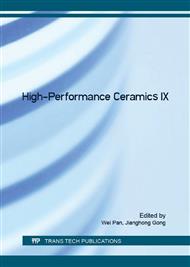p.419
p.423
p.428
p.433
p.437
p.441
p.445
p.449
p.453
Effects of Concentrations of NaCl on the Sintering and Thermal Conductivity of Forsterite
Abstract:
This paper aims to study the effects of NaCl on the sintering of forsterite as well as the thermal conductivity of the sintering products. In the sintering process, NaCl played a role in the system by mainly providing a liquid phase sintering environment in order to promote grain growth and forsterite sintering. Moreover, the model of liquid phase sintering was established in this paper. In the initial sintering stage, the phenomenon of particle re-arrangement was not significant, and dissolution-precipitation was regarded as the dominant sintering mechanism. With the extension of the sintering time, the middle and later stages of the sintering process were mainly controlled by the diffusion mechanism. A test of the thermal conductivity of samples with 40% and 50% NaCl was carried out, which indicated that the thermal conductivity of the two samples ranged from 0.3 to 0.4 W·m-1·k-1. At the same temperatures, the thermal conductivity of the sample with a salt content of 50% was lower than that of the sample with a salt concentration of 40%. Also, the heat insulation effect of the sample with a salt content of 50% was better than that of the sample of 40% . Hence, it can be concluded that the higher the salt content in the sample, the lower the thermal conductivity of the sample.
Info:
Periodical:
Pages:
437-440
Citation:
Online since:
July 2016
Authors:
Keywords:
Price:
Сopyright:
© 2016 Trans Tech Publications Ltd. All Rights Reserved
Share:
Citation:


